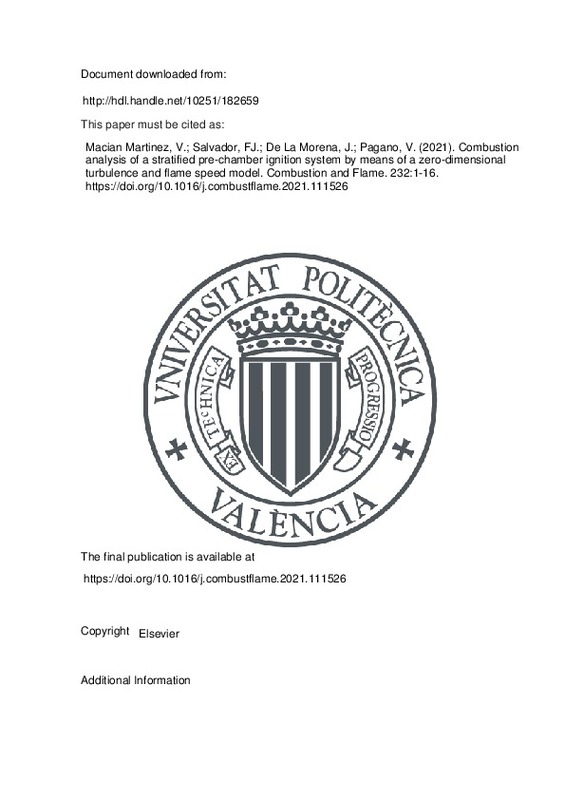JavaScript is disabled for your browser. Some features of this site may not work without it.
Buscar en RiuNet
Listar
Mi cuenta
Estadísticas
Ayuda RiuNet
Admin. UPV
Combustion analysis of a stratified pre-chamber ignition system by means of a zero-dimensional turbulence and flame speed model
Mostrar el registro sencillo del ítem
Ficheros en el ítem
| dc.contributor.author | Macian Martinez, Vicente
|
es_ES |
| dc.contributor.author | Salvador, Francisco Javier
|
es_ES |
| dc.contributor.author | De La Morena, Joaquín
|
es_ES |
| dc.contributor.author | Pagano, V.
|
es_ES |
| dc.date.accessioned | 2022-05-17T18:03:54Z | |
| dc.date.available | 2022-05-17T18:03:54Z | |
| dc.date.issued | 2021-10 | es_ES |
| dc.identifier.issn | 0010-2180 | es_ES |
| dc.identifier.uri | http://hdl.handle.net/10251/182659 | |
| dc.description.abstract | [EN] In the current work, the combustion process inside a stratified pre-chamber ignition system is analyzed. The pre-chamber is installed on a Rapid Compression-Expansion Machine (RCEM) and runs at different combinations of fuel-air equivalence ratio in the main chamber as well as in the pre-chamber, which is controlled by a fuel injection during the compression stroke. In order to analyze the results in detail, a zero-dimensional model for the pre-chamber is proposed. First, a K-k- epsilon model is developed and calibrated according to three-dimensional simulations in motoring conditions performed in a Computational Fluid Dynamic solver (Converge). Then, a thermodynamic model including the mass exchange between both chambers as wells as the heat transfer losses to the walls is used to compute the instantaneous heat release rate in the pre-chamber. Both pieces of information are combined to evaluate the effective flame propagation speed, and also to decouple the effects in terms of laminar flame speed, turbulenceflame interaction and gas velocity due to expansion effects in the burned products. The flame speed values obtained are consistent when the equivalence ratio in the pre-chamber is maintained, regardless the conditions in the main chamber, while a significant deterioration is seen once lean operation appears in the pre-chamber. Finally, the flame speed is compared to an average propagation speed estimated from broadband chemiluminescence visualization tests, showing good consistency with the model predictions. | es_ES |
| dc.language | Inglés | es_ES |
| dc.publisher | Elsevier | es_ES |
| dc.relation.ispartof | Combustion and Flame | es_ES |
| dc.rights | Reconocimiento - No comercial - Sin obra derivada (by-nc-nd) | es_ES |
| dc.subject | Pre-chamber | es_ES |
| dc.subject | Turbulence | es_ES |
| dc.subject | Flame speed | es_ES |
| dc.subject | Heat release | es_ES |
| dc.subject.classification | MAQUINAS Y MOTORES TERMICOS | es_ES |
| dc.title | Combustion analysis of a stratified pre-chamber ignition system by means of a zero-dimensional turbulence and flame speed model | es_ES |
| dc.type | Artículo | es_ES |
| dc.identifier.doi | 10.1016/j.combustflame.2021.111526 | es_ES |
| dc.rights.accessRights | Abierto | es_ES |
| dc.contributor.affiliation | Universitat Politècnica de València. Departamento de Máquinas y Motores Térmicos - Departament de Màquines i Motors Tèrmics | es_ES |
| dc.description.bibliographicCitation | Macian Martinez, V.; Salvador, FJ.; De La Morena, J.; Pagano, V. (2021). Combustion analysis of a stratified pre-chamber ignition system by means of a zero-dimensional turbulence and flame speed model. Combustion and Flame. 232:1-16. https://doi.org/10.1016/j.combustflame.2021.111526 | es_ES |
| dc.description.accrualMethod | S | es_ES |
| dc.relation.publisherversion | https://doi.org/10.1016/j.combustflame.2021.111526 | es_ES |
| dc.description.upvformatpinicio | 1 | es_ES |
| dc.description.upvformatpfin | 16 | es_ES |
| dc.type.version | info:eu-repo/semantics/publishedVersion | es_ES |
| dc.description.volume | 232 | es_ES |
| dc.relation.pasarela | S\439427 | es_ES |







![[Cerrado]](/themes/UPV/images/candado.png)

